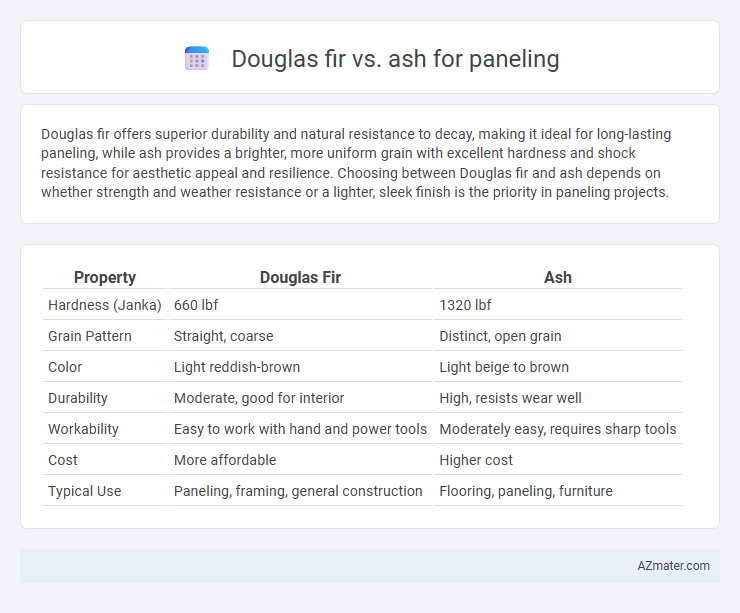Douglas fir offers superior durability and natural resistance to decay, making it ideal for long-lasting paneling, while ash provides a brighter, more uniform grain with excellent hardness and shock resistance for aesthetic appeal and resilience. Choosing between Douglas fir and ash depends on whether strength and weather resistance or a lighter, sleek finish is the priority in paneling projects.
Table of Comparison
| Property | Douglas Fir | Ash |
|---|---|---|
| Hardness (Janka) | 660 lbf | 1320 lbf |
| Grain Pattern | Straight, coarse | Distinct, open grain |
| Color | Light reddish-brown | Light beige to brown |
| Durability | Moderate, good for interior | High, resists wear well |
| Workability | Easy to work with hand and power tools | Moderately easy, requires sharp tools |
| Cost | More affordable | Higher cost |
| Typical Use | Paneling, framing, general construction | Flooring, paneling, furniture |
Introduction to Douglas Fir and Ash as Paneling Options
Douglas fir offers a warm, amber hue with a straight, pronounced grain pattern, making it a popular choice for paneling that emphasizes natural beauty and durability. Ash features a light, creamy color with a smooth texture and distinct grain that adds a bright, modern aesthetic to interior spaces. Both woods provide excellent workability and can be finished to enhance their unique characteristics, catering to diverse design preferences in paneling applications.
Wood Grain and Aesthetic Differences
Douglas fir features a straight, uniform grain with a coarse texture, offering a warm honey to reddish-brown color that deepens with age, making it ideal for rustic or natural paneling aesthetics. Ash presents a more pronounced, distinctive grain pattern with contrasting light and dark streaks in creamy white to light brown hues, providing a vibrant, contemporary look for interior spaces. The choice between Douglas fir and Ash for paneling hinges on the desired visual impact: Douglas fir emphasizes subtle warmth and consistency, while Ash highlights bold grain character and high contrast.
Durability and Hardness Comparison
Douglas fir offers moderate hardness with a Janka rating around 660, making it reasonably durable for interior paneling but prone to dents and scratches over time. Ash, known for its higher hardness rating of approximately 1320 on the Janka scale, provides greater durability and resistance to wear, making it a superior choice for heavy-use areas. Both woods have good dimensional stability, but ash's increased hardness enhances its lifespan and robustness for paneling applications.
Color and Aging Over Time
Douglas fir boasts a warm reddish-brown hue that deepens to a richer amber over time, enhancing its natural grain and providing a timeless aesthetic for paneling. Ash features a lighter, creamy color with subtle grain patterns that gradually darken to a soft honey tone, maintaining a bright and airy feel in interior spaces. Both woods age gracefully, but Douglas fir develops a more pronounced patina compared to ash's softer color shift, influencing long-term design choices.
Workability and Installation Ease
Douglas fir offers excellent workability due to its straight grain and uniform texture, making it easy to cut, shape, and finish, which accelerates installation time for paneling projects. Ash is also workable but tends to be harder and denser, requiring sharper tools and more effort for precise cuts, potentially increasing installation difficulty. Both woods provide stability, but Douglas fir's lighter weight typically enhances ease of handling and fastening during the paneling process.
Cost and Value Considerations
Douglas fir paneling offers a cost-effective option with moderate pricing and durability, making it suitable for budget-conscious projects without sacrificing aesthetic appeal. Ash paneling tends to be more expensive due to its hardness, rich grain pattern, and superior wear resistance, providing long-term value through enhanced durability and a visually striking finish. When balancing initial investment and lasting quality, Douglas fir delivers affordability while ash represents a premium choice that improves property value over time.
Environmental Impact and Sustainability
Douglas fir paneling offers a more sustainable choice due to its rapid growth rate and high carbon sequestration, making it an eco-friendly option compared to ash. Ash trees grow slower and their harvesting often impacts biodiversity more significantly, increasing environmental concerns. Choosing Douglas fir supports lower carbon emissions and promotes responsible forest management practices.
Maintenance and Longevity
Douglas fir paneling offers superior durability with natural resistance to decay and insect damage, requiring minimal maintenance to preserve its appearance over time. Ash, while aesthetically appealing with its light color and prominent grain, demands more frequent sealing and protective treatments due to its moderate susceptibility to moisture and wear. Choosing Douglas fir ensures longer-lasting paneling with reduced upkeep compared to Ash, making it ideal for high-traffic or moisture-prone areas.
Best Applications for Each Wood Type
Douglas fir excels in paneling applications requiring strength, stability, and rich reddish-brown hues, making it ideal for structural walls, accent panels, and rustic interiors. Ash offers a lighter color with a smooth grain, perfect for modern, bright spaces and decorative wall treatments seeking a clean, contemporary aesthetic. Both woods provide durability, but Douglas fir suits load-bearing panels while ash is better for visually striking, fine-finished surfaces.
Summary: Which Wood Is Best for Paneling?
Douglas fir offers excellent durability and straight grain patterns, making it ideal for high-quality, long-lasting paneling with a warm, reddish tone. Ash is prized for its light color and prominent grain, providing a more contemporary, bright appearance that suits lighter interior designs. For robust, traditional paneling, Douglas fir is best, while ash is preferred for modern, airy spaces.

Infographic: Douglas fir vs Ash for Paneling
 azmater.com
azmater.com